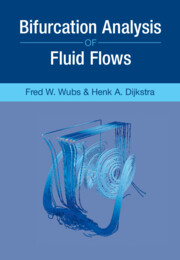Refine search
Actions for selected content:
8126 results in Fluid dynamics and solid mechanics
6 - Single-Phase Turbulent Flow
-
- Book:
- Fluid Dynamics of Particles, Drops, and Bubbles
- Published online:
- 28 July 2023
- Print publication:
- 17 August 2023, pp 222-285
-
- Chapter
- Export citation
9 - Drag Force on an Isolated Particle
-
- Book:
- Fluid Dynamics of Particles, Drops, and Bubbles
- Published online:
- 28 July 2023
- Print publication:
- 17 August 2023, pp 398-446
-
- Chapter
- Export citation
1 - Introduction to Multiphase Fluid Dynamics
-
- Book:
- Fluid Dynamics of Particles, Drops, and Bubbles
- Published online:
- 28 July 2023
- Print publication:
- 17 August 2023, pp 1-34
-
- Chapter
-
- You have access
- Export citation
Contents
-
- Book:
- Fluid Dynamics of Particles, Drops, and Bubbles
- Published online:
- 28 July 2023
- Print publication:
- 17 August 2023, pp v-x
-
- Chapter
- Export citation
8 - Multiphase Flow Numerical Approaches
-
- Book:
- Fluid Dynamics of Particles, Drops, and Bubbles
- Published online:
- 28 July 2023
- Print publication:
- 17 August 2023, pp 354-397
-
- Chapter
- Export citation
Appendix
-
- Book:
- Fluid Dynamics of Particles, Drops, and Bubbles
- Published online:
- 28 July 2023
- Print publication:
- 17 August 2023, pp 518-518
-
- Chapter
- Export citation
Frontmatter
-
- Book:
- Fluid Dynamics of Particles, Drops, and Bubbles
- Published online:
- 28 July 2023
- Print publication:
- 17 August 2023, pp i-iv
-
- Chapter
- Export citation
11 - Particle Interactions with Walls and Other Particles
-
- Book:
- Fluid Dynamics of Particles, Drops, and Bubbles
- Published online:
- 28 July 2023
- Print publication:
- 17 August 2023, pp 476-517
-
- Chapter
- Export citation
Preface
-
- Book:
- Fluid Dynamics of Particles, Drops, and Bubbles
- Published online:
- 28 July 2023
- Print publication:
- 17 August 2023, pp xi-xi
-
- Chapter
- Export citation
5 - Coupling Regimes for Multiphase Flow
-
- Book:
- Fluid Dynamics of Particles, Drops, and Bubbles
- Published online:
- 28 July 2023
- Print publication:
- 17 August 2023, pp 192-221
-
- Chapter
- Export citation
Nomenclature
-
- Book:
- Fluid Dynamics of Particles, Drops, and Bubbles
- Published online:
- 28 July 2023
- Print publication:
- 17 August 2023, pp xiii-xx
-
- Chapter
- Export citation
10 - Lift, Added-Mass, and History Forces on a Particle
-
- Book:
- Fluid Dynamics of Particles, Drops, and Bubbles
- Published online:
- 28 July 2023
- Print publication:
- 17 August 2023, pp 447-475
-
- Chapter
- Export citation
4 - Particle Sizes, Shapes, and Trajectories
-
- Book:
- Fluid Dynamics of Particles, Drops, and Bubbles
- Published online:
- 28 July 2023
- Print publication:
- 17 August 2023, pp 130-191
-
- Chapter
- Export citation
Acknowledgments
-
- Book:
- Fluid Dynamics of Particles, Drops, and Bubbles
- Published online:
- 28 July 2023
- Print publication:
- 17 August 2023, pp xii-xii
-
- Chapter
- Export citation
7 - Multiphase Turbulent Flow
-
- Book:
- Fluid Dynamics of Particles, Drops, and Bubbles
- Published online:
- 28 July 2023
- Print publication:
- 17 August 2023, pp 286-353
-
- Chapter
- Export citation
References
-
- Book:
- Fluid Dynamics of Particles, Drops, and Bubbles
- Published online:
- 28 July 2023
- Print publication:
- 17 August 2023, pp 519-547
-
- Chapter
- Export citation
NUMERICAL SIMULATIONS FOR LARGELY DEFORMED BEAMS AND RINGS ADOPTING A NONTENSILE SMOOTHED PARTICLE HYDRODYNAMICS ALGORITHM
- Part of
-
- Journal:
- The ANZIAM Journal / Volume 64 / Issue 4 / October 2022
- Published online by Cambridge University Press:
- 15 August 2023, pp. 355-379
-
- Article
-
- You have access
- Open access
- HTML
- Export citation
BURSTING SOLUTIONS OF THE RÖSSLER EQUATIONS
- Part of
-
- Journal:
- The ANZIAM Journal / Volume 65 / Issue 1-2 / January 2023
- Published online by Cambridge University Press:
- 10 August 2023, pp. 93-110
-
- Article
-
- You have access
- Open access
- HTML
- Export citation

Bifurcation Analysis of Fluid Flows
-
- Published online:
- 03 August 2023
- Print publication:
- 24 August 2023
THE ROLE OF THE MATHEMATICAL SCIENCES IN SUPPORTING THE COVID-19 RESPONSE IN AUSTRALIA AND NEW ZEALAND
-
- Journal:
- The ANZIAM Journal / Volume 64 / Issue 4 / October 2022
- Published online by Cambridge University Press:
- 31 July 2023, pp. 315-337
-
- Article
-
- You have access
- Open access
- HTML
- Export citation

